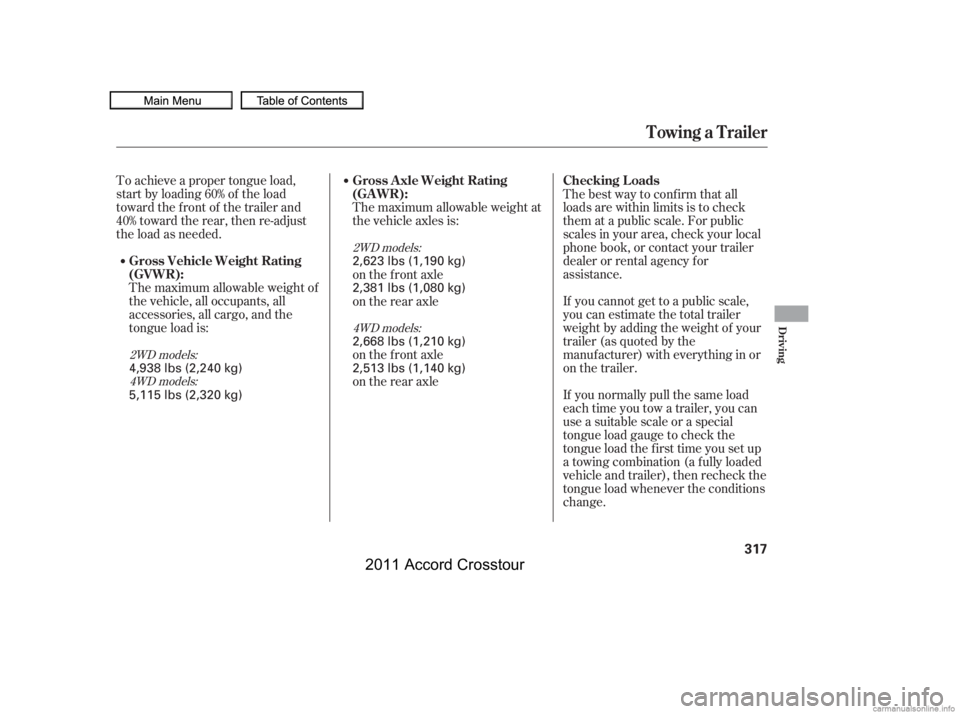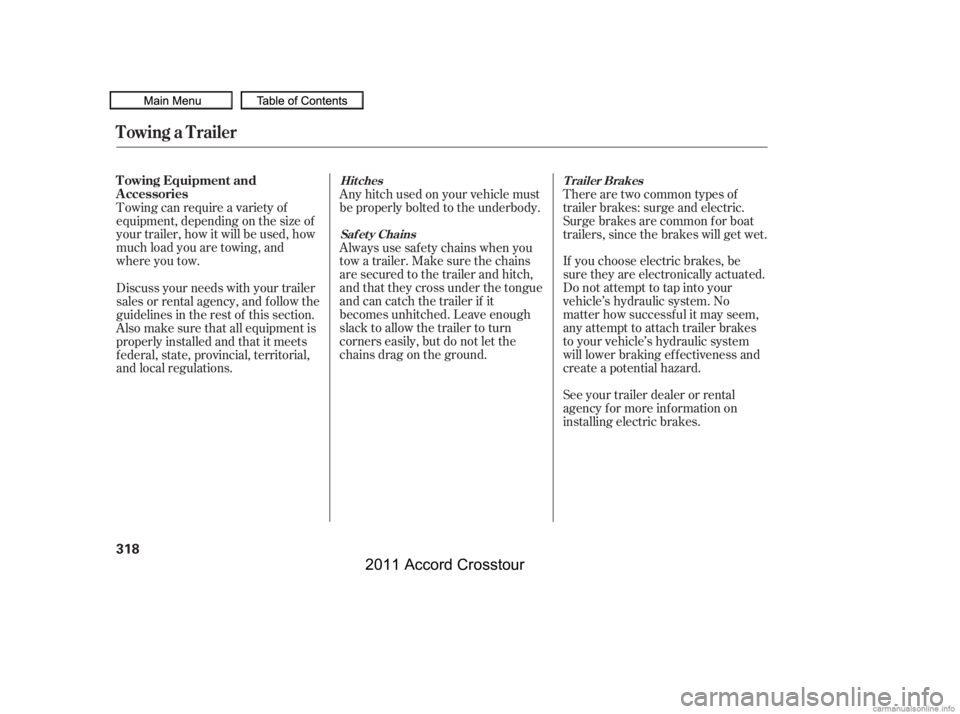Page 320 of 434

To achieve a proper tongue load,
start by loading 60% of the load
toward the front of the trailer and
40% toward the rear, then re-adjust
the load as needed.The maximum allowable weight of
the vehicle, all occupants, all
accessories, all cargo, and the
tongue load is: The maximum allowable weight at
the vehicle axles is:
Thebestwaytoconfirmthatall
loads are within limits is to check
them at a public scale. For public
scales in your area, check your local
phone book, or contact your trailer
dealer or rental agency for
assistance.
If you cannot get to a public scale,
you can estimate the total trailer
weight by adding the weight of your
trailer (as quoted by the
manuf acturer) with everything in or
on the trailer.
If you normally pull the same load
each time you tow a trailer, you can
use a suitable scale or a special
tongue load gauge to check the
tongue load the f irst time you set up
a towing combination (a f ully loaded
vehicle and trailer), then recheck the
tongue load whenever the conditions
change.
on the f ront axle
on the rear axle
on the f ront axle
on the rear axle
2WD models:
4WD models:
2WD models: 4WD models:
Gross Vehicle Weight Rating
(GVWR): Checking L oads
Gross Axle Weight Rating
(GA WR):
Towing a Trailer
Driving
317
4,938 lbs (2,240 kg) 2,623 lbs (1,190 kg)
2,381 lbs (1,080 kg)
5,115 lbs (2,320 kg) 2,668 lbs (1,210 kg)
2,513 lbs (1,140 kg)
10/08/27 14:56:30 31TP6610_322
2011 Accord Crosstour
Page 321 of 434

If you choose electric brakes, be
sure they are electronically actuated.
Do not attempt to tap into your
vehicle’s hydraulic system. No
matter how successf ul it may seem,
any attempt to attach trailer brakes
to your vehicle’s hydraulic system
will lower braking ef f ectiveness and
create a potential hazard.
Seeyourtrailerdealerorrental
agency f or more inf ormation on
installing electric brakes.
Towing can require a variety of
equipment, depending on the size of
your trailer, how it will be used, how
much load you are towing, and
where you tow.
Any hitch used on your vehicle must
be properly bolted to the underbody.
Always use saf ety chains when you
tow a trailer. Make sure the chains
are secured to the trailer and hitch,
and that they cross under the tongue
and can catch the trailer if it
becomes unhitched. Leave enough
slack to allow the trailer to turn
corners easily, but do not let the
chains drag on the ground.There are two common types of
trailer brakes: surge and electric.
Surge brakes are common f or boat
trailers, since the brakes will get wet.
Discuss your needs with your trailer
sales or rental agency, and f ollow the
guidelines in the rest of this section.
Also make sure that all equipment is
properly installed and that it meets
f ederal, state, provincial, territorial,
and local regulations.
Trailer Brakes
Hitches
Saf et y ChainsT owing Equipment and
A ccessories
Towing a Trailer
318
10/08/27 14:56:38 31TP6610_323
2011 Accord Crosstour
Page 322 of 434

CONT INUED
Trailer lights and equipment must
comply with f ederal, state, provincial,
territorial, and local regulations.
Check with your local trailer dealer
or rental agency for the
requirements in the area where you
plan to tow, and use only equipment
designed f or your vehicle.Since lighting and wiring vary by
trailer type and brand, you should
have a qualif ied technician install a
suitable connector between the
vehicle and the trailer. Improper
equipment or installation can cause
damage to your vehicle’s electrical
system and af f ect your vehicle
warranty.
Your vehicle has a trailer lighting
connector located behind the lef t
side panel in the cargo area. Ref er to
thedrawingaboveforthewiring
color code and purpose of each pin.
If you use a non-Honda trailer
lighting harness and converter, you
can get the connector and pins that
mate with the connector in your
vehicle f rom your dealer.
T railer L ights
Towing a Trailer
Driving
319
GROUND
(BLACK) TRAILER
(YELLOW) LEFT TURN
SIGNAL (BLUE)
BRAKE
LIGHT
(LIGHT
GREEN) TAILLIGHT
(RED)
RIGHT TURN
SIGNAL
(GREEN)
10/08/27 14:56:45 31TP6610_324
2011 Accord Crosstour
Page 323 of 434

The lights and brakes on your
vehicle and the trailer are working
properly.
Your vehicle tires and spare are
properly inf lated, and the trailer
tires and spare are inflated as
recommended by the trailer
maker.
Askyourtrailersalesorrental
agency if any other items are
recommended or required f or your
towing situation. When preparing to tow, and bef ore
driving away, be sure to check the
f ollowing:
Many states and Canadian
provinces/territories require special
outside mirrors when towing a trailer.
Even if they don’t, you should install
special mirrors if you cannot clearly
see behind you, or if the trailer
creates a blind spot. The vehicle has been properly
serviced, and the suspension and
the cooling system are in good
operating condition.
The trailer has been properly
serviced and is in good condition.
All weights and loads are within
limits.
Thehitch,safetychains,andany
other attachments are secure.
All items in or on the trailer are
properly secured and cannot shif t
while you drive.
Towing a Trailer
A ddit ional T owing EquipmentPre-T ow Checklist
320
10/08/27 14:56:54 31TP6610_325
2011 Accord Crosstour
Page 324 of 434

When driving down hills, reduce
your speed, and shif t down to second
gear. Do not ‘‘ride’’ the brakes, and
remember, it will take longer to slow
downandstopwhentowingatrailer.
If youmuststopwhenfacinguphill,
use the f oot brake or parking brake.
Do not try to hold the vehicle in
place by pressing on the accelerator,
as this can cause the automatic
transmission to overheat.
Crosswinds and air turbulence
caused by passing trucks can disrupt
your steering and cause the trailer to
sway. When being passed by a large
vehicle, keep a constant speed, and
steer straight ahead. Do not try to
make quick steering or braking
corrections.
Maketurnsmoreslowlyandwider
than normal. The trailer tracks a
smaller arc than your vehicle, and it
canhitorrunoversomethingthe
vehicle misses. Allow more time and
distance f or braking. Do not brake or
turn suddenly as this could cause the
trailer to jackknif e or turn over.
When climbing hills, closely watch
your temperature gauge. If it nears
the red (Hot) mark, turn the air
conditioning of f , reduce speed and, if
necessary, pull to the side of the
road to let the engine cool.
The added weight, length, and
height of a trailer will af f ect your
vehicle’s handling and perf ormance,
so driving with a trailer requires
some special driving skills and
techniques.
Foryoursafetyandthesafetyof
others,taketimetopracticedriving
maneuvers bef ore heading f or the
open road, and f ollow the guidelines
in this section.
Drive slower than normal in all
driving situations, and obey posted
speed limits f or vehicles with trailers.
Use the D position when towing a
trailer on level roads. D3 is the
proper shif t lever position to use
when towing a trailer in hilly terrain.
(See ‘‘
’’ in the
f ollowing column f or additional gear
inf ormation.) If the automatic transmission shifts
f requently while going up a hill, shif t
to D3.
Towing a Trailer
Handling Crosswinds and Buf f et ing
Making T urns and Braking
Driving on Hills
T owing Speeds and Gears
Driving on Hills
Driving Saf ely With a T railer
Driving
321
10/08/27 14:57:04 31TP6610_326
2011 Accord Crosstour
Page 325 of 434
Always drive slowly and have
someone guide you when backing up.
Grip the of the steering wheel,
then turn the wheel to the left to get
the trailer to move to the lef t. Turn
the wheel to the right to move the
trailer to the right.
Follow all normal precautions when
parking, including f irmly setting the
parking brake and putting the
transmission in Park. Also, place
wheel chocks at each of the trailer’sYour vehicle is not designed to be
towed behind a motor home. If your
vehicle needs to be towed in an
emergency, see page .
397
bottom
Towing a Trailer
Backing Up
ParkingTowing Your Vehicle
322
10/08/27 14:57:10 31TP6610_327
tires.
2011 Accord Crosstour
Page 334 of 434

�Î
�Î
�Ì �Ì
�µ
�µ
�Ì�Î
Maintenance Minder
331
Maintenance Main Items
Replace engine oil
Replace engine oil and oil filter
Inspect front and rear brakes
Check parking brake adjustment
Inspect these items: Tie rod ends, steering gear box, and boots
Suspension components
Driveshaft boots
Brake hoses and lines (including ABS/VSA)
All fluid levels and condition of fluids
Exhaust system
Fuel lines and connections Maintenance Sub Items
Rotate tires
Replace air cleaner element
Replace dust and pollen filter
Inspect drive belt
Replace transmission and transfer fluid (4WD only)
Replace spark plugs
Replace timing belt and inspect water pump
Inspect valve clearance
Replace engine coolant
Replace rear differential fluid (4WD only)
:
A
B
Symbol
1
2
3
4
Symbol
6 51
1
Inspect idle speed every 160,000 miles (256,000 km).
If the message ‘‘SERVICE’’ does not appear more than 12 months after the
display is reset, change the engine oil every year.
See information on maintenance and emissions warranty in the center
column on page .
Adjust the valves during services A, B, 1, 2, or 3 if they are noisy. Independent of the Maintenance Minder information, replace the brake
fluid every 3 years.
NOTE: 1:
330
TM
If you drive in dusty conditions, replace every 15,000
miles (24,000 km).
If you drive primarily in urban areas that have high
concentrations of soot in the air from industry and from
diesel-powered vehicles, replace every 15,000 miles
(24,000 km).
If you drive regularly in very high temperatures (over
110°F, 43°C), in very low temperatures (under 20°F,29°C) or tow a trailer, replace every 60,000 miles
(U.S.)/100,000 km (Canada).
Maintenance Minder
10/08/27 14:58:27 31TP6610_336
2011 Accord Crosstour
Page 346 of 434

�µ�µ
Always use Honda Power Steering
Fluid. You may use another power
steering f luid as an emergency
replacement, but have the power
steering system f lushed and ref illed
with Honda PSF as soon as possible.
A low power steering f luid level can
indicate a leak in the system. Check
the f luid level f requently, and have
the system inspected as soon as
possible.
Pour the f luid slowly and caref ully
so you do not spill any. Clean up
any spills immediately; it could
damage components in the engine
compartment. Check the level on the side of the
reservoir when the engine is cold.
The f luid should be between the
UPPER LEVEL and LOWER LEVEL.
If not, add power steering f luid to the
UPPER LEVEL. The timing belt should be replaced
according to the Maintenance
Minder (see page ).
Replace the timing belt every 60,000
miles (100,000 km) if you regularly
drive your vehicle in any of the
f ollowing conditions:
In very high temperatures
(over 110°F, 43°C).
In very low temperatures
(under 20°F, 29°C).
Frequently towing a trailer. 331
Timing Belt
Power Steering Fluid
Power Steering Fluid, Timing Belt
Maint enance
343
UPPER LEVEL
LOWER LEVELTM
Turning the steering wheel to f ull lef t
or right lock and holding it there can
damage the power steering pump.
10/08/31 13:35:56 31TP6610_348
2011 Accord Crosstour